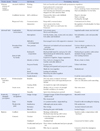Abstract
Purpose
The purpose of this study was to explore the experiences of nursing college students who attended delivery practices at midwifery clinic.
Methods
This was a qualitative study using focus groups. Data were collected by group interviews with a total of 12 students who observed natural childbirth at midwifery clinic. Data were analyzed through Colaizzi's method in which meaningful statements were extracted.
Results
The meanings of experiences were identified five theme clusters from thirteen themes and thirty-one sub-themes. The five theme clusters were 'ultimate process of natural childbirth', 'allowed birth', 'role recognition of the midwife', 'positively changed perception', and 'barriers'.
Conclusion
This study showed that observation of delivery at midwifery clinic was helpful for nursing students in terms of positive impression about natural childbirth with maternal and baby being centered. Nursing students expressed value and concern about delivery at midwifery clinic. Further in-depth study of natural childbirth in terms of husband and family perspective is required. For quality improvement of maternity nursing care, natural childbirth process needs to be included in nursing care at hospitals as well as students' clinical practicum.
Figures and Tables
Table 1
Experiences of Nursing College Students Attended to Delivery at Midwifery Clinic

References
1. Davis E, Pascali-Bonaro D. Orgasmic birth: Your guide to a safe, satisfying, and pleasurable birth experience. NY: Rodale Books;2010.
2. Lee SH. Women's experiences on spontaneous delivery with midwives [Dissertation]. Seoul: Ewha Womans University;2012.
3. McCourt C. How midwives should organise to provide intrapartum care. In : Walsh D, Downes S, editors. Essential midwifery practice: Intrapartum care. Oxford: Wiley-Blackwell;2010. p. 253–274.
4. Oh HE, Sim GS, Kim JS. The effects of prenatal education on primiparas' perception of delivery experience, self-confidence and satisfaction in maternal role performance. Korean J Women Health Nurs. 2002; 8(2):268–277.

5. Callister LC. Making meaning: Women's birth narratives. J Obstet Gynecol Neonatal Nurs. 2004; 33(4):508–518.

6. Nilsson C, Bondas T, Lundgren I. Previous birth experience in women with intense fear of childbirth. J Obstet Gynecol Neonatal Nurs. 2010; 39:298–309.

7. Encyclopedia Britannica. Natural childbirth [Internet]. Chicago: Encyclopedia Britannica;cite 2015 March 12. Available from: http://global.britannica.com/EBchecked/topic/406123/natural-childbirth.
8. Park MR. Mother's perception of childbirth experience, labor pain, newborn's pain and maternal attachment behaviors with Leboyer method [master's thesis]. Daegu: Keimyung University;2010.
9. Kim MJ. Nursing students lived experiences of attending Le-Boyer birth. Korean J Women Health Nurs. 2012; 18(1):62–73.

10. Kang ML, Kim SK, Bang JM, An JE, Yun Y, Lee SH, et al. The comparison of perception of birth experience to women who had a hospital delivery and those who a maternity hospital delivery. J Nurs Acad Assoc Ewha Womans Univ. 2005; 39:119–141.
11. O'Brien B, Chalmers B, Fell D, Heaman M, Darling EK, Herbert P. The experience of pregnancy and birth with midwives: Results from the Canadian maternity experiences survey. Birth. 2011; 38(3):207–215.
12. Janssen PA, Saxell L, Page LA, Klein MC, Liston RM, Lee SK. Outcomes of planned home birth with registered midwife versus planned hospital birth with midwife or physician. CMAJ. 2009; 181(6-7):377–383.

13. Yeo JH. A nursing college women's meaning of labor and delivery: Phenomenological method. J Korean Acad Womens Health Nurs. 2001; 7(2):203–211.
14. Korean Statistical Information Service. Annual report of normal delivery statistics Internet]. Seoul: Korean Statistical Information Service;2008. cite 2013 November 12. Available from: http://kosis.kr/statHtml/statHtml.do?orgId=117&tblId=TX_117_2009_H8207&vw_cd=&list_id=&scrId=&seqNo=&lang_mode=ko&obj_var_id=&itm_id=&conn_path=K1&path=#.
15. Kim JH. Experiences of self-directed birth: The birth of new self [Dissertaion]. Seoul: Yonsei University;2003.
16. Yeo JH. Attitudinal type on delivery for college women. J Korean Acad Nurs. 2001; 31(6):1088–1097.

17. Jung OB, Park HJ. Experience on delivery room practice of male nursing students. Korean J Women Health Nurs. 2011; 17(1):64–76.

18. Kim SJ, Kim HJ, Lee KJ, Lee SO. Focus group kit. Seoul: Hyunmoonsa;2000.
19. Shin KL, Cho MO, Yang JH. Qualitative Research Methodology. Seoul: Ewha Womans University Press;2004.
20. Colaizzi P. Psychological research as the phenomenologist views it. In : Valle R, King M, editors. Existential phenomenological alternatives for psychology. NY: Oxford University Press;1978.
21. Lincoln YS, Guba EG. Naturalistic inquiry. Beverly Hills: CA Sage;1985.
22. Morison S, Percival P, Hauck Y, McMurray A. Birthing at home: The resolution of expectations. Midwifery. 1999; 15(1):32–39.

23. Gibbins J, Thomson AM. Women's expectations and experiences of childbirth. Midwifery. 2001; 17(4):302–313.

24. Hildingsson I, Radestad I, Lindgren H. Birth preferences that deriviate from the norm in Sweden: Planned home birth versus planned cesarean section. Birth. 2010; 37(4):288–295.
26. Fraser DM, Hughes AJ. Perceptions of motherhood: The effect of experience and knowledge on midwifery students. Midwifery. 2009; 25(3):307–316.

27. Eom SY, Kim ES, Kim HJ, Bang YO, Chun NM. Effects of one session spouse-support enhancement childbirth education on childbirth self-efficacy and perception of childbirth experience in women and their husbands. J Korean Acad Nurs. 2012; 42(4):599–607.
28. Hur MH. Effects of one-to-one labor support on labor pain, labor stress response, childbirth experience and neonatal status for primipara. J Korean Acad Womens Health Nurs. 2001; 7(2):188–202.




 PDF
PDF ePub
ePub Citation
Citation Print
Print


 XML Download
XML Download